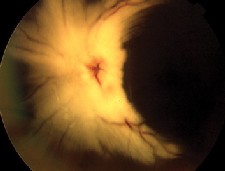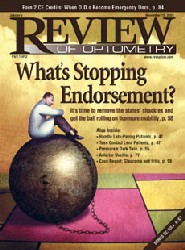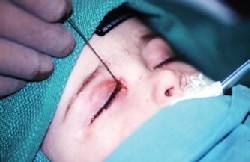I read with interest Dr. Dunbars article on the child with medullated nerve fibers and refractive amblyopia (Retina Quiz, November 2003). Two points came to mind about his discussion:
1. Although the medullation does not require a visual field be conducted, the diagnosis of amblyopia ALWAYS requires a visual field to rule out occult neurologic disease. At least one infamous malpractice case has demonstrated this need.
2. Dr. Dunbars casual statement about the age of the child (11) and the shallowness of the deviation bears further scrutiny. Repeated studies by many authors have shown that amblyopia essentially remains treatable, regardless of age. No mention was made of the childs binocular status, and amblyopia is not fully treated unless the suppression is eliminated.
While I appreciate the intent of the article, the myths regarding proper medicolegal and clinical care that it includes were too significant to ignore.
Patrick J. Pirotte, O.D., Wichita, Kan.
Dr. Dunbar Responds:

Reader says Retina Quiz, November 2003, includes myths regarding medicolegal and clinical care of patients such as this one, with medullated nerve fibers and refractive amblyopia.
I thank Dr. Pirotte for his interest in the Retina Quiz column and his comments regarding the patient with amblyopia and medullated nerve fibers. However, I disagree with his statement that the diagnosis of amblyopia cannot be made unless a visual field is performed and in fact ALWAYS requires a visual field to rule out occult neurologic disease.
In the typical setting of obvious amblyopiasuch as a patient with reduced visual acuity in one eye and a large amount of anisometropia in that same eye, or a young child with reduced vision in one eye and a confirmed history of infantile esotropia from birth in that same eye, or even reduced vision in one eye in the setting of uncorrected accommodative esotropiaa visual field is not indicated, as the amblyopia is easily explainable and supported by the examination findings. In fact, a visual field may be impossible to obtain because of the childs young age. Yet we still feel confident making that diagnosis in those types of settings provided we have done a complete exam, including a dilated fundus exam in which we look carefully at the optic nerve, macula and the rest of the fundus, and the findings support that diagnosis.
Dr. Pirotte argues for obtaining visual fields on presumed amblyopia based on the outcome of an infamous malpractice case. He does not say which malpractice case he is referring to, or discuss the specific nature of the case; however, I believe I know the case he is referring to. It involved a 13 year-old child with a recent history of reduced acuity who was inappropriately diagnosed with lazy eye when the child really had a brain tumor.
The pertinent points of the case were that the child did not have anisometropia, nor was there any strabismus or other cause for the reduced acuity. In the course of a year, the patient continued to have a progressive decrease in the visual acuity to a profoundly poor level.
Endorsement? We Have Bigger Fish to Fry
As a young doctor, I have consistently been and continue to be denied entry into a significant number of managed-care plans in my area. In my humble opinion, the most pressing issue
facing optometry today is not "illegal" contact lens sales, evil commercial practice, oversupply of O.D.s or reciprocity/endorsement. It is the continued discrimination against O.D.s by a tremendous number of managed-care plans in this country.

This issue makes endorsement and scope-of-practice issues moot. It does not make one lick of difference what my training is or what my state license says I can do if I cannot get paid for it.
Nothing sticks in my gut more than having to refer patients out into the ophthalmology vortex, not because of a lack of training, ability, or desire to treat the patient, but because of the arbitrary policies of insurance companies.
Expanding scope of practice and licensure endorsement will mean absolutely nothing if we cannot get paid for the services which we are seeking the right to provide.
Ken Elder O.D., nipidoc@earthlink.net
Limited National Licenses
Does it have to be this difficult? Why not offer a general optometric license that is good in all states?
Such a license would be obtained by passing a test for the state in which you want a new license. It would allow you to perform general exams and contact lens fittings only. You would only be able to prescribe therapeutically for what you are currently trained. This would allow a doctor to get his foot in the door of a state in which he wishes to practice and, once settled, he may then pursue any extra credentialing the state may require to practice full-scope optometry inside its borders.
If the right people got together, something like this could happen in our lifetime. What exists now is nothing more than a roadblock to all practicing O.D.s who want to obtain another states license. Test results such as National Boards and TMODs should not expire once passed; only the needed updates for the new licensing states therapeutic capabilities should be required.
The protectionism that is rampant in optometry is only going to hurt our profession in the long run.
Thomas Ruppert, O.D., tkz123@hereintown.net
The important point is that the childs reduced acuity was mistakenly blamed on amblyopia when the exam findings did not support that diagnosis. In that instance, a visual field perhaps would have been helpful in determining a neurologic cause for the reduced acuity.
A visual field is important when the exam findings dont always add up to a conclusive diagnosis and you would like additional information. Even then, a visual field may not rule in or out the presence of neurologic disease, and a referral and/or further testing may be indicated.
Our patient had severe myelinated nerve fiber and a significant amount of anisometropia. As stated in the discussion, amblyopia has been well documented in this setting, so given all the other findings, we did not feel we needed a visual field to support the diagnosis. It would be interesting to know if the field is affected with so much MNF. We will try to obtain a visual field when she returns for follow-up.
The question of patching this 11-year-old patient is an interesting one, and unfortunately, remains debatablehopefully for not too much longer. The benefits of patching amblyopia up to ages 7-9 are generally well accepted in the ophthalmic literature. Beyond that age, the benefits of patching are less clear. Certainly there is evidence, either anecdotally or in small case series, showing that vision can improve in older individuals, but when to do it, for how long, and under what circumstances has not been well established.
One question being addressed by the NEIs Amblyopia Treatment Study (ATS) is how successful patching therapy is in older individuals with amblyopia. In other words, what is the age limit, if any, for amblyopia therapy? How old can a person be and still have a significant and lasting improvement in acuity? Our patient was 20/30 best corrected with 4.00D of anisometropia, so perhaps patching should have been considered.
We did do sensory function tests, although they were not included in the column due to space limitations. The patient had 40 seconds of stereo and did not have suppression on the Worths four dot test.
Once again, I thank Dr. Pirotte for his comments and interest in this case. Like all good questions, it has forced us to think about some other issues that we would not have otherwise considered.Mark T. Dunbar, O.D.
Pediatric Optometry
I enjoyed the article by Drs. Hoppe and Skorin in the December 2003 Review of
Optometry regarding nasolacrimal duct stenosis. As an optometrist practicing at a childrens hospital for the past 10 years, I am in favor of seeing more articles and education on the primary-care aspects of pediatrics.

Pediatric optometry has been associated with vision therapy for far too long. Optometry needs to address pediatric eye care as it does adult eye care: emphasizing the understanding of underlying pathology and comanagement with pediatric ophthalmology to include surgical referrals when appropriate. This will strengthen our position as competent primary eye-care providers.
Timothy Hug, O.D., thug@cmh.edu

